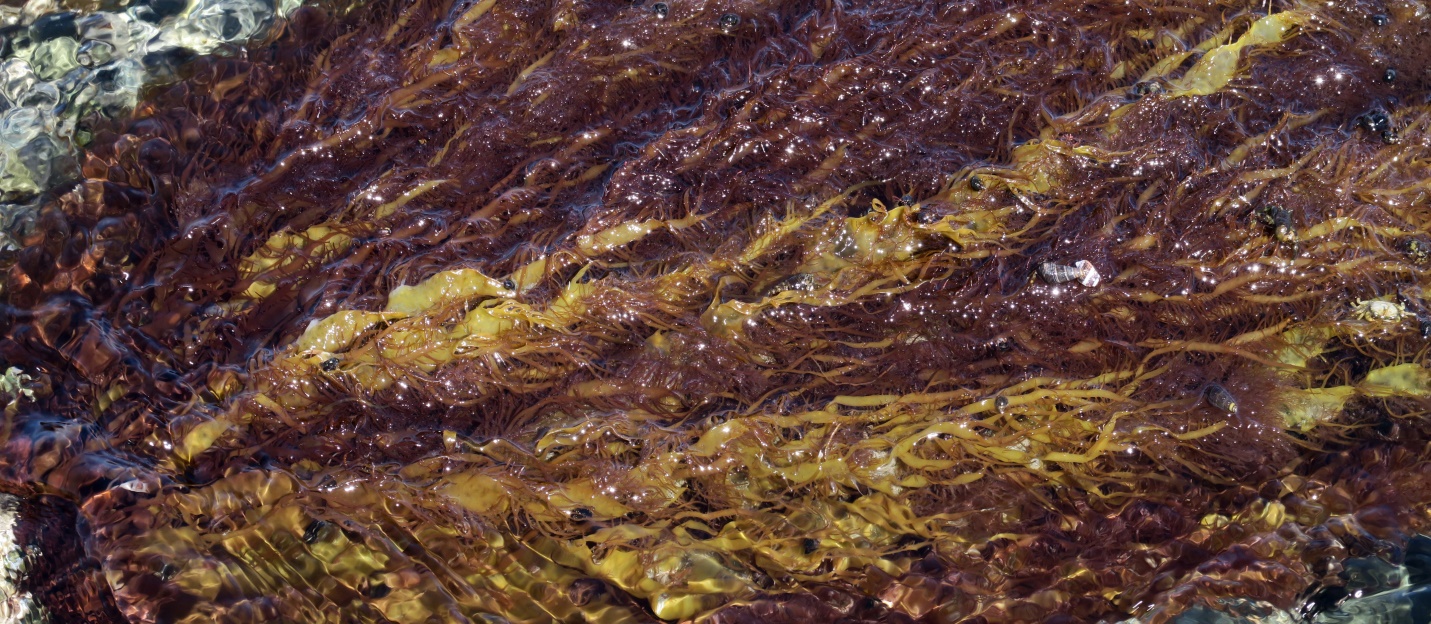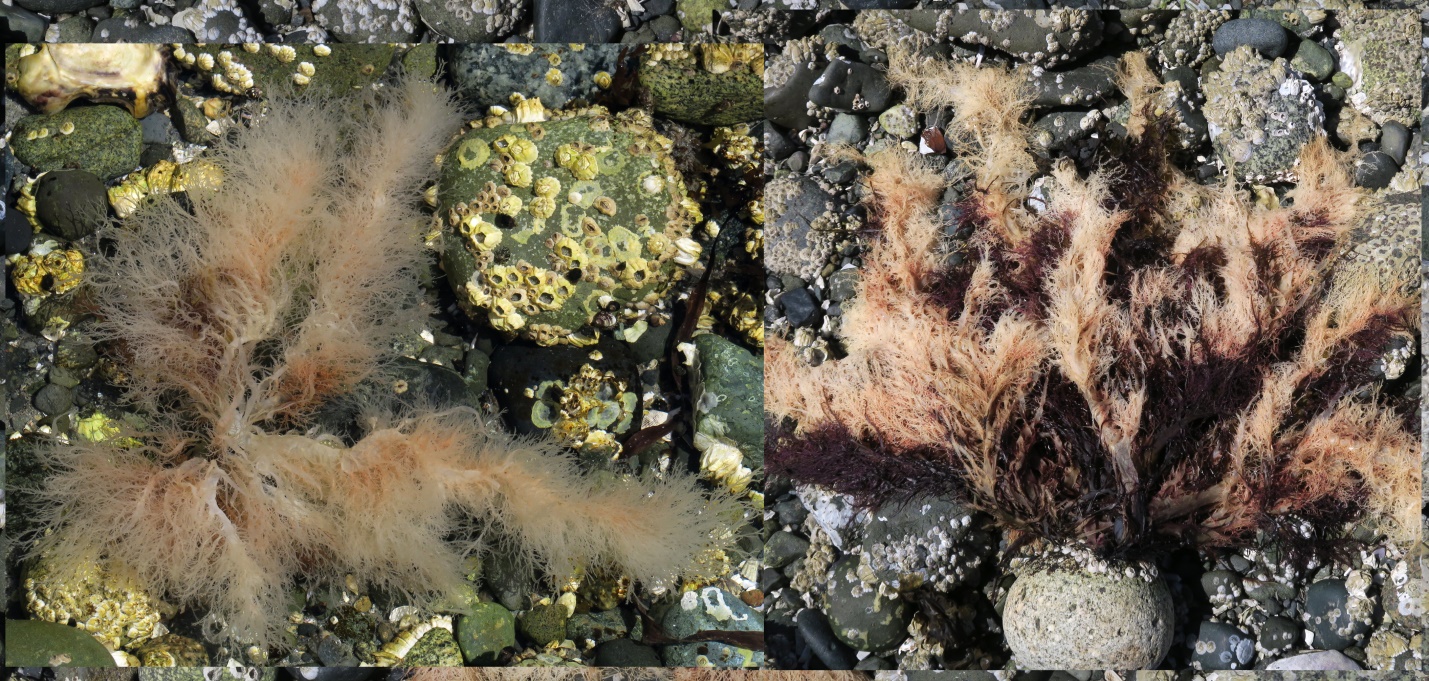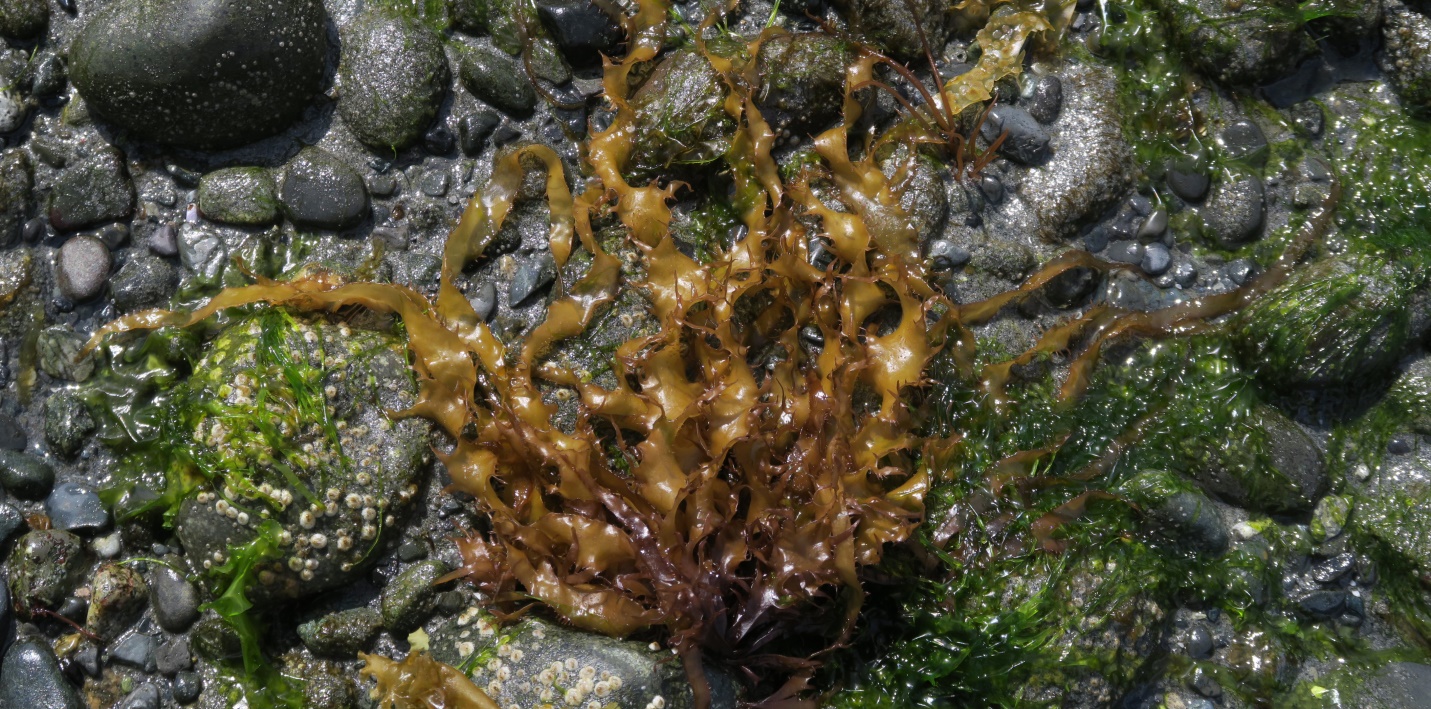
Grateloupia doryphora
Shaft-bearing Iodine Seaweed, [Twisty-turny Tasseled Iodine Weed]
Interaction conducted: 24 June 2021, (start time 11:50am PDT)
Little Qualicum Estuary, Strait of Georgia, B.C., Canada.
Tide: 0.3 foot tide 12:15pm PDT (measured at Winchelsea Islands Tidal Station)
Conditions: Mostly clear (10% cloud cover), no precipitation, wind NE 15 km/hr, light chop, 22˚C.
Phase of Moon: Waning Gibbous (approx. 35 minutes into this phase at time of interaction); (Previous Phase, Full Moon, 24 June 2021 at 11:39am PDT: Next Phase, Third Quarter, 1 July 2021 at 2:10pm PDT.)

Figure 1: Several blades of Grateloupia doryphora are seen here as they flitter in the current that is emptying a large, shallow tide pool with the falling tide. At this season this red alga is both red and yellow; the yellow a sign of low nitrogen levels in the summer shallow waters. Little Qualicum Estuary, Strait of Georgia, B.C., Canada. June 24, 2021. Photo ID 27298 ©Seaweedwhisperings.com
Person 1:
I looked at an exposed dry bleached specimen.
Flopped out in the hot sun.
Wasted, tired, like an old dog.
Bleached parts form a netted tangle.
Broad center of stems give it a bit of shape.
I then observed some of this same seaweed afloat in nearby tidepools.
Not bleached yet.
Untidy appearance, quite messy actually.
Central stem has twisted appearance.
Beauty is in the detail, obscured by overall ugliness.
Stems look like dragons with spines and spikes radiating out.
One specimen in the “stream” looked like spawning salmon swishing back and forth, waiting to lay eggs and then die.
Can tolerate and thrive in warm tide pools. The water here today could be more than 20˚C, whereas the open waters of the strait are only about 13˚C.

Figure 2: On the left a specimen is pictured that has bleached to palest pink with a few remaining hints of the original deep red color. Most Grateloupia species smell “like bleach” when crushed, and they also “bleach” in color rather dramatically. The photo to the right shows an individual splayed out and desiccated at low tide. Little Qualicum Estuary, Strait of Georgia, B.C., Canada. June 24, 2021. Photo ID 27299 ©Seaweedwhisperings.com
Person 2:
In the channel – as the area drains with the receding tide, your longish stems stretch out downstream. You seem to enjoy flowing with the water, but you also don’t look like you could resist that flow even if you tried your best.
Your many shafts look twisted and they are all trimmed with many “tassel” looking branchlets.
Overall look is distinctive and to my eye a bit comical – like a young girl dressed up in her mother’s out of style party clothes.
Whether you suit my taste or not, you catch the eye, grab attention.
Your color seems to be olive green and trimmed with red-brown.
The shaft is lighter colored and the tassels darker.
Are you red fading out, or are you green rusting to red?
Do you know?
Found a specimen bleached so very white, with just a hint of pink at your core. After viewing several of these algae and then finding the first pinky white one, I laughed to myself, and thought, “You’re “Boopy Loopy!” Again, here appears the comical and light quality.
Like a fancy groomed poodle, curls and bows and shaven hair – and where is the true you? Is it the haircut and bows…, is it something more?
Unsure?
Not settled on it yet?
But you’re playing with it, definitely playing.
New and young.
I’m making up names – “Boopy Loopy”. Are you making up who you are?
I moved to some specimens that grew on higher ground at the beach here. Today they are totally desiccated.
Core is dark red-brown burgundy. Tips are bleached a very pale off white.
Even here in this desiccated state you show off a bit – like a peacock plume or a dress with many tassels or fringes.
It’s not too smart (although we’re clad with sun hats and long sleeves for sun protection) for us to be out exploring here today – we really feel the exposure to sun. But we had no choice in the matter as the low tide occurred at noon on this unusually warm June day.
You, too, Grateloupia, the water you are in is almost at a comfy bath temperature.
Is that wise?
Are you foolish? Or simply rather inexperienced?
But you go for it anyway, Grateloupia, you put on your best party dress and proceed with willingness to try it out.
Boopy Loopy! Betty Boopy! Pertly dressed up in a 1920’s Flapper dress – that’s what you look like.

Figure 3: Grateloupia doryphora seen two months earlier in the season; far fewer ‘frill’s adorn the central shafts. Little Qualicum Estuary, Strait of Georgia, B.C., Canada. April 29, 2021. Photo ID 27300 ©Seaweedwhisperings.com
Biology & Natural History Information:
Description:
Thallus narrow to broad lanceolate, having a soft gel-like texture. Blades can be red, olive green, purple to yellowish in color, stemming from a single holdfast anchor point. Blades, which can grow to more than 3cm wide, are often incised in the upper half with margins of short and narrow fringe-like proliferations (less than 1mm wide); blade is sometimes plane. Several narrow blades are produced from a single broad flat stipe. In our region the central shaft is often twisted in a spiral, loosely or rather uniformly.
Habitat:
Shaft-bearing Iodine Seaweed grows in sheltered and exposed areas by attaching to solid substrates such as rocks, loose stones, shells and artificial structures. It preferentially develops in currents and pools of the lower intertidal and upper subtidal and is abundant between early winter and mid-summer. It can survive water temperatures between 4 and 28 C and salinities between 12 and 52 parts per thousand.
Distribution:
This red alga is most likely native to Peru and is has been introduced to numerous coastlines of the world. Some specimens have been identified on ships hulls and pontoons, suggestive of the mechanism for distant geographical propagation of the species. It is also thought to have been transported to new locations via oyster spawn importations and dumping of ballast water. Grateloupia doryphora tends to proliferate in settling locations, and in some regions is regarded as potentially invasive.
Remarks:
This red alga can be highly variable in color and also morphology. The yellow coloration that is often observed is most common in summer as nitrates in the surrounding surface water are in low supply. Some authors suggest that all Grateloupia species on the British Columbia coast are “poorly understood and require further study.”
Classification:
Phylum: Rhodophyta
Class: Florideophyceae
Order: Halymeniales
Family: Halymeniaceae
Genus: Grateloupia
Species: Grateloupia doryphora (Montagne) M.Howe 1914
Previous name(s): The basionym for this species is Halymenia doryphora Montagne
![]()